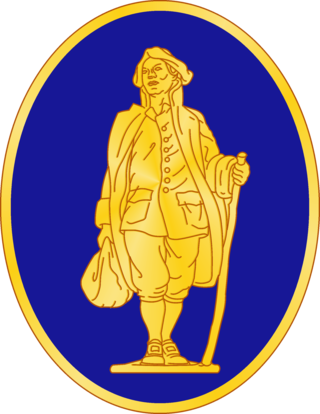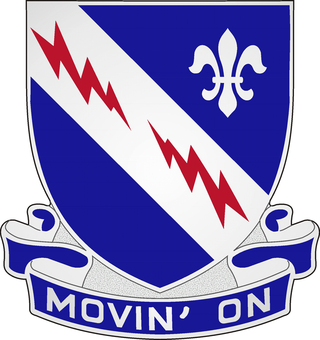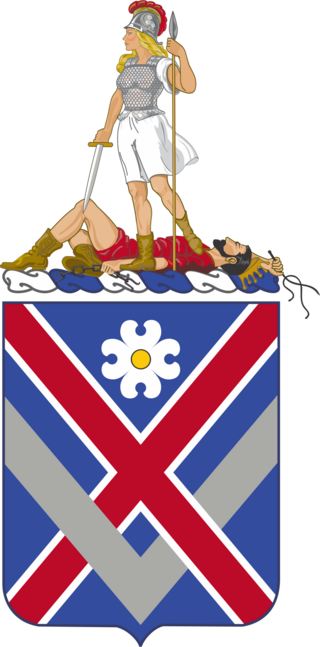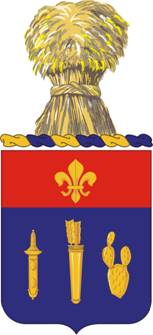The 198th Signal Battalion is an Expeditionary Signal Battalion in the Delaware Army National Guard. Delaware is known as the "First State," as referenced in their motto "First Regiment of First State." The unit specializes in command post node communications, providing broadband satellite voice and data connections for brigade sized battlefield elements. The unit includes Headquarters, Headquarters Company located in Wilmington, DE; A Company in Georgetown, DE; B Company in Hodges, SC; and C Company in Wilmington, DE. It is one of several National Guard units with colonial roots and campaign credit for the War of 1812.

The 112th Infantry Regiment, also known as the Sixteenth Pennsylvania, is a unit in the Pennsylvania National Guard which can trace its lineage back to before the American Civil War.
The 102nd Field Artillery Regiment is an inactive Field Artillery Regiment in the Massachusetts Army National Guard. Originally organized in 1786, the 102nd Field Artillery's predecessor units served in the Civil War, the Spanish–American War, and World War I. Units of the regiment served with the 26th Infantry Division during World War II and the Cold War.
The 141st Infantry Regiment is an infantry regiment in the United States Army. The lineage of the 141st includes units tracing origins to the Texas Revolution, such as Company A, First Texas, 1836, and other infantry companies of the First Texas formed in the 1870s and 1880s.

The 111th Infantry Regiment, was originally the Pennsylvania Militia or "Associators" that fought in the American Revolution, composed of civilian males from the citizenry of Pennsylvania. It is one of several National Guard units with colonial roots and campaign credit for the War of 1812. The Pennsylvania Militia often fought in conjunction with General Washington and the Continental Army along the Delaware River. Today the idea of a Pennsylvania Militia is represented in the U.S. Army by 1st Battalion, 111th Infantry assigned to the Pennsylvania Army National Guard's 56th Stryker Brigade Combat Team, 28th Infantry Division. The regiment, founded as the Associators by Benjamin Franklin in Philadelphia, Pennsylvania on 21 November 1747, is the oldest regiment in Pennsylvania.

The 124th Infantry Regiment is a parent regiment of the United States Army, represented in the Florida Army National Guard by the 1st Battalion headquartered in Miramar and 2nd Battalion at Orlando. The two Battalions are elements of the 53rd Infantry Brigade Combat Team.

The 102nd Cavalry Regiment is a regiment of the United States Army first established in 1913 and which saw service in World War II.

The 146th Field Artillery Regiment is a field artillery regiment of the Army National Guard first Constituted in 1886 as the 1st, and 2nd Regiments of Infantry.
Twenty-four current units of the Army National Guard perpetuate the lineages of militia units mustered into federal service during the War of 1812. Militia units from nine states that were part of the Union by the end of the War of 1812, plus the District of Columbia, are the predecessors of eighteen units that currently exist in the Army National Guard. Two of the four units derived from Virginia militias are in the West Virginia National Guard; at the time of the War of 1812, West Virginia was still part of Virginia. Only two current units, the 155th Infantry, a component of the Mississippi National Guard derived from militia units organized in the Mississippi Territory and the 130th Infantry, a component of the Illinois National Guard derived from militia units formed in the Illinois Territory, are from states or territories west of the Appalachians. Unfortunately, no militia units from the states of Kentucky, Louisiana, Ohio or Tennessee, or from the Indiana, Michigan, Missouri or Louisiana Territories, where militia units played a major role in the fighting, have survived as units in the modern Army National Guard.

The 1st Battalion, 279th Infantry Regiment is headquartered in Sand Springs, Oklahoma. It is a part of the 45th Infantry Brigade Combat Team, Oklahoma Army National Guard.

The 113th Infantry Regiment is an Infantry regiment of the New Jersey Army National Guard. It is one of several National Guard units with colonial roots and campaign credit for the War of 1812.

The 130th Infantry Regiment is an infantry regiment in the Army National Guard. It is one of several Army National Guard units with campaign credit for the War of 1812.

The 133rd Infantry Regiment is an infantry regiment in the Iowa Army National Guard. It is represented by the 1st Battalion, 133rd Infantry Regiment, part of the 2nd Infantry Brigade Combat Team, 34th Infantry Division.

The 134th Cavalry Regiment is a cavalry regiment in the Nebraska Army National Guard. By extension, it is a member of the United States Army National Guard, and as a currently federally-recognized unit, also a member of the National Guard of the United States.

The 135th Infantry Regiment is an infantry regiment in the Minnesota Army National Guard.

The 107th Field Artillery Regiment is a Field Artillery Branch regiment of the United States Army. It has been affiliated with the Pennsylvania National Guard since its formation. It appears that the regiment last formally came into existence in June 1959, when the 107th Field Artillery Battalion was reorganized as the new Regiment's 1st Battalion in line with the Pentomic (ROCID) reorganization going on at that time.
The 114th Infantry Regiment is an Infantry regiment of the New Jersey Army National Guard.

The 183rd Cavalry Regiment is a cavalry regiment of the United States Army, represented in the Virginia Army National Guard by 2nd Squadron, 183rd Cavalry (2-183). The squadron is the reconnaissance, surveillance, and target acquisition squadron of the 116th Infantry Brigade Combat Team, part of the 29th Infantry Division.
The 118th Field Artillery Regiment is a field artillery regiment of the Georgia Army National Guard. The regiment's 1st Battalion is the cannon battalion assigned to the 48th Infantry Brigade Combat Team. It is one of several National Guard units with colonial roots and campaign credit for the War of 1812.

The 125th Field Artillery Regiment is a field artillery regiment of the Minnesota Army National Guard. The regiment's 1st Battalion is the 155mm, self-propelled cannon battalion assigned to the 1st Armored Brigade Combat Team, 34th Infantry Division.















